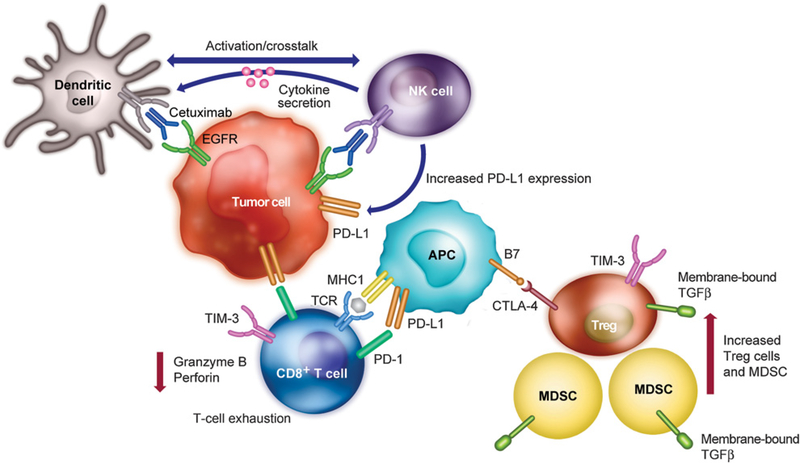Figure 1.
Immune activity mediated by cetuximab in the SCCHN tumor microenvironment. Binding of cetuximab to EGFR recruits CD8+ T cells, which are activated through MHC complex/TCR and B7/CTLA-4 binding. In responders to treatment, cetuximab-mediated activation of NK cells induces dendritic cell maturation via crosstalk to promote antigen presentation and lyse tumor cells through ADCC. However, cetuximab binding also recruits and expands the Treg population in the tumor microenvironment. These Treg cells inhibit cetuximab-mediated cytotoxicity via expression of immune checkpoint molecules such as PD-1, PD-L1, CTLA-4, and TIM-3. Upregulation of these immune checkpoint molecules is associated with the exhausted T-cell phenotype, as seen in nonresponders to cetuximab treatment. Immunosuppressive TGFβ is also expressed on Treg cells as well as accumulating MDSCs, leading to inhibition of cytolytic activity via reduced levels of granzyme B and perforin. ADCC, antibody-dependent cellular cytotoxicity; APC, antigen presenting cell; CTLA-4, cytotoxic T-lymphocyte-associated antigen 4; EGFR, epidermal growth factor receptor; MDSC, myeloid-derived suppressor cell; NK, natural killer; PD-1, programmed cell death protein 1; PD-L1, programmed death ligand 1; SCCHN, squamous cell carcinoma of the head and neck; TCR, T-cell receptor; TIM-3, T-cell immunoglobulin and mucin-domain containing-3; Treg, regulatory T cell.

